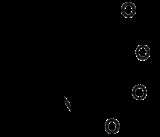
Kainic acid
Encyclopedia
Kainic acid is a natural marine acid present in some seaweed
. It is a specific agonist
for the kainate receptor
used as an ionotropic glutamate receptor
which mimics the effect of glutamate. Along with quisqualate
, it is used in experiments to distinguish a receptor from the other ionotropic receptors for glutamate such as NMDA
and AMPA
.
called "Kainin-sou"(海人草) or "Makuri" (Digenea simplex) in Japan
. "Kainin-sou" is used as an anthelmintic
in Japan
.
Kainic acid is a potent central nervous system
stimulant, and has been developed as the prototype neuroexcitatory amino acid for the induction of seizures in experimental animals, at a typical dose of 10-30 mg/kg in mice. Kainic acid is neuroexcitotoxic and epileptogenic, acting through specific kainate receptor
s. Because of the supply shortage in 2000, the price of kainic acid has risen significantly.
Seaweed
Seaweed is a loose, colloquial term encompassing macroscopic, multicellular, benthic marine algae. The term includes some members of the red, brown and green algae...
. It is a specific agonist
Agonist
An agonist is a chemical that binds to a receptor of a cell and triggers a response by that cell. Agonists often mimic the action of a naturally occurring substance...
for the kainate receptor
Kainate receptor
Kainate receptors, or KARs, are non-NMDA ionotropic receptors which respond to the neurotransmitter glutamate. They were first identified as a distinct receptor type through their selective activation by the agonist kainate, a drug first isolated from red algae Digenea simplex. KARs are less well...
used as an ionotropic glutamate receptor
Ionotropic glutamate receptor
The ability of synapses to modify their synaptic strength in response to activity is a fundamental property of the nervous system and may be an essential component of learning and memory. There are three classes of ionotropic glutamate receptor, namely NMDA , AMPA and kainate receptors...
which mimics the effect of glutamate. Along with quisqualate
Quisqualic acid
Quisqualic acid is an agonist for both AMPA receptors and group I metabotropic glutamate receptors. It causes excitotoxicity and is used in neuroscience to selectively destroy neurons in the brain or spinal cord...
, it is used in experiments to distinguish a receptor from the other ionotropic receptors for glutamate such as NMDA
NMDA
N-Methyl-D-aspartic acid or N-Methyl-D-aspartate is an amino acid derivative which acts as a specific agonist at the NMDA receptor mimicking the action of glutamate, the neurotransmitter which normally acts at that receptor...
and AMPA
AMPA
AMPA is a compound that is a specific agonist for the AMPA receptor, where it mimics the effects of the neurotransmitter glutamate....
.
Occurrence
In 1953, kainic acid was originally isolated from the seaweedSeaweed
Seaweed is a loose, colloquial term encompassing macroscopic, multicellular, benthic marine algae. The term includes some members of the red, brown and green algae...
called "Kainin-sou"(海人草) or "Makuri" (Digenea simplex) in Japan
Japan
Japan is an island nation in East Asia. Located in the Pacific Ocean, it lies to the east of the Sea of Japan, China, North Korea, South Korea and Russia, stretching from the Sea of Okhotsk in the north to the East China Sea and Taiwan in the south...
. "Kainin-sou" is used as an anthelmintic
Anthelmintic
Anthelmintics or antihelminthics are drugs that expel parasitic worms from the body, by either stunning or killing them. They may also be called vermifuges or vermicides .-Pharmaceutical classes:...
in Japan
Japan
Japan is an island nation in East Asia. Located in the Pacific Ocean, it lies to the east of the Sea of Japan, China, North Korea, South Korea and Russia, stretching from the Sea of Okhotsk in the north to the East China Sea and Taiwan in the south...
.
Kainic acid is a potent central nervous system
Central nervous system
The central nervous system is the part of the nervous system that integrates the information that it receives from, and coordinates the activity of, all parts of the bodies of bilaterian animals—that is, all multicellular animals except sponges and radially symmetric animals such as jellyfish...
stimulant, and has been developed as the prototype neuroexcitatory amino acid for the induction of seizures in experimental animals, at a typical dose of 10-30 mg/kg in mice. Kainic acid is neuroexcitotoxic and epileptogenic, acting through specific kainate receptor
Kainate receptor
Kainate receptors, or KARs, are non-NMDA ionotropic receptors which respond to the neurotransmitter glutamate. They were first identified as a distinct receptor type through their selective activation by the agonist kainate, a drug first isolated from red algae Digenea simplex. KARs are less well...
s. Because of the supply shortage in 2000, the price of kainic acid has risen significantly.
Applications
- antiworming agent
- neuroscienceNeuroscienceNeuroscience is the scientific study of the nervous system. Traditionally, neuroscience has been seen as a branch of biology. However, it is currently an interdisciplinary science that collaborates with other fields such as chemistry, computer science, engineering, linguistics, mathematics,...
research- neurodegenerative agent
- modeling of epilepsyEpilepsyEpilepsy is a common chronic neurological disorder characterized by seizures. These seizures are transient signs and/or symptoms of abnormal, excessive or hypersynchronous neuronal activity in the brain.About 50 million people worldwide have epilepsy, and nearly two out of every three new cases...
- modeling of Alzheimer's diseaseAlzheimer's diseaseAlzheimer's disease also known in medical literature as Alzheimer disease is the most common form of dementia. There is no cure for the disease, which worsens as it progresses, and eventually leads to death...

